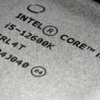Final Words & Conclusion
Final Words
Out of the three models released by Intel this week, the Core i5 12600K is going to offer the best value. Alder lake is a tremendous step forward for Intel, the architecture is sound and works. Much like its bigger brother, we can nitpick on the topic of power consumption, but other than that, they deliver really sweet performance. Intel has come a long way, but the new architecture shows very powerful performance cores. Basically, this is a 6-core processor at 12 threads paired with 4 additional energy-efficient CPU cores (+4 threads). The combination is solid and offers a product series that can compete extremely well with AMD's Ryzen Series 5000 high-end processors and even the high-end Gen 10 and 11 series Intel processors in the same class.
Performance
If we only look at the performance cores, Intel did an excellent job at designing them. They provide the most efficient single-threaded performance available on the market. Of course, multithreaded performance is not an issue either. At 289 USD the Core i5 12600K puts up a tremendous fight against AMD's Ryzen 7 5800X, 8C/16T (379 EUR/USD) as well as tearing a hole in relative performance compared to last-gen 11600K, it can even beat the 11900K here and there. We need to factor in the platform cost of ownership though. Making a move to Z690 presumably, you'll want DDR5, easily destroying that price benefit. Gaming wise Intel now has the faster processors, but as always, we test with the fastest GPU available (GeForce RTX 3090), and only up to 2560x1440 you'll notice gains. But even then the differences in performance can be argued. With a slower GPU the graphics card is the bottleneck in graphics intense games, ergo the benefit of a faster CPU vanishes rapidly. The thing we all need to get used to is the performance versus energy cores. The one thing that this architecture shows is that it's less energy efficient compared to a 5950X at 7nm. So for me, the E cores are not a selling point. It however can be beneficial in demanding workloads where your application uses the P cores, and the E cores still do your background work properly. It remains trivial though. I've been thinking about the fact as to why intel did not pursue 12 or 16 cores P cores and strip away the E cores. But it's obvious energy consumption would become an issue overall. Regardlessly, no matter what I think or how I feel about it, Intel's solution does work extremely well making this among the fastest processors on the globe. Gaming wise as mentioned Intel has a win. We still need to check out and rule out the performance differential with a DDR4 motherboard. I'll already state this though, in the beginning opting for a DDR4 motherboard might save you some money as transitioning to the new platform. But a lot of money on a Z690 motherboard is needed in general, you'd be better off going with DDR5 straight from the start.
DDR5 Memory
Memory compatibility should not and likely will not be an issue as long as you stick to QVL supported DIMMs. The current sweet spot looks to be 5200 MHz DDR5 Cl38 or CL40. Check out Corsair's and G.Skills offering to start with, as they'll have impressive stuff to offer. We have three DDR5 kits at hand, they all are plug and play. E.g. insert them in the DIMM slots, apply the proper SPD/XMP profile and you're ready to roll. In our testing, we used the G.Skill Ripjaws S CL40 kits and the Corsair Dominator Cl38 kit. Both run fairly equal in performance. Nice is that Corsair will support storing two user-created SPD profiles in the memory, so if you can find a sweet spot tweak, you can store it inside the DIMMs as a profile. This is to be implemented at a later stage though.
Z690
So yes, LGA1700 ... these motherboards will start at roughly 250 USD ranging towards let's say 800 USD and with some very exclusive boards even passing 1000 USD. By definition a cheaper 250 USD Z690 motherboard will not be a lot slower than an 800USD one, however, it's all about features. The cheaper ones will be conforming closer to reference specs (more limited PL2 states), the expensive ones will have far higher and longer P states and thus offer a notch more performance in the long run as well as having more exclusive VRM power designs. Next to that the motherboards support features such as 2.5 GiGE connectors, WIFI6E (AX) network solutions, and of course are PCIe Gen 5.0 compatible, you're ready for something really fast and you'll be future proof with such a platform. The platform overall felt stable and refined, we can't say anything else here as that is the honest truth.
Energy efficiency
With these processors now fabbed at 10nm, you may see some interesting energy efficiency; we expected to drop dead low IDLE energy levels due to the E-cores, but the system comes back at 70~80 Watts power draw in IDLE, granted our motherboard does have a roughly 5 Watts of RGB going on and has a lot of extra chips (ethernet/wifi/thunderbolt) that require energy, but even then it's quite a lot. PCI Express 5.0 also is part of the problem here, it simply requires more energy. The system under full stress on the processors comes back at roughly ~225 Watts and overclocked we reached 350 Watts. Energy efficiency for this motherboard and processors as such are average at best. Heep that in mind with your choice of cooling, as processor wattage used usually is 1:1 in line with cooling performance. We recommend LCS or a premium, heatpipe cooling solution.
| Core | Thread | Clock speed | L3 cache | Proc Base Power | Max Turbo Power | |||||
| Base E | Boost E | Base P | Boost P All cores | Boost P 1-core | ||||||
| Core i9-12900K | 8P+8E | 24 | 2.4 | 3.9 | 3.2GHz | 5.2 | 5.3GHz | 30MB | 125W | 241W |
| Core i9-12900KF | 8P+8E | 24 | 2.4 | 3.9 | 3.2GHz | 5.2 | 5.3GHz | 30MB | 125W | 241W |
| Core i7-12700K | 8P+4E | 20 | 2.7 | 3.8 | 3.6GHz | 5.0 | 5.0GHz | 25MB | 125W | 190W |
| Core i7-12700KF | 8P+4E | 20 | 2.7 | 3.8 | 3.6GHz | 5.0 | 5.0GHz | 25MB | 125W | 190W |
| Core i5-12600K | 6P+4E | 16 | 2.8 | 3.6 | 3.7GHz | - | 4.9GHz | 20MB | 125W | 150W |
| Core i5-12600KF | 6P+4E | 16 | 2.8 | 3.6 | 3.7GHz | - | 4.9GHz | 20MB | 125W | 150W |
Note on integrated graphics
We'd have loved to show you some scores and benchmarks on the integrated Xe GPU. Unfortunately, we have an issue where the IGP will not POST with the current BIOS on the ASUS boards, the MSI board we have does not have a display output. We'll follow up on this soon.
Overclocking
Depending on your objectives, there are numerous approaches to overclock an Intel platform. With the Core i9-12600K you'll achieve roughly 5.0~5.1 GHz across all performance cores, that however will depend and vary per processor, motherboard and cooling. The proc is going to need something like 1.4 Volts. Most modern motherboards will have an automated setting for that. All 6 performance cores we had overclocked to 5.2 GHz but it was just not stable enough. The tweak overall will cost you another 125W in energy consumption. We gained 5% extra performance due to this. As such, we feel overclocking is a bit unneeded perhaps even an illogical thing to do. But you can if you want to and this platform certainly will assist you greatly with it. That said, the 12600K overclocked worse than the 12900K did.
The conclusion
Numbers always speak for themselves; if you seek a notch more value for money and don't have a use for massive threading then the Core i5 12600K(F) probably will be the processor to get. It's strong and fierce, the single-threaded performance is downright excellent, the multi-threaded performance puts it in Ryzen 7 5800X and 11900K territory. For a processor priced like that you'll reap the benefits in gaming, applications as well as the impressive (Z690) platform. All factors combined make this a truly worthwhile upgrade to a new ECO system. We do feel that the Core i5 12600K will be more interesting over the 12700K/12900K series for the vast majority of people as with its 8+4 cores and 20 threads the CPU absolutely delivers. We're not imbued that much about the inclusion of energy-efficient cores as they just do not matter to me if it does not bring IDLE and low load power consumption down. Overall platform power consumption is considerably higher than what AMD offers. The thing that Intel does have going for it is of course the extremely fast single-threaded performance, and CPU bound gaming does like that. When you look at multi-core performance the Intel is at Ryzen 5800X level with a differential here and there. IPC for the P cores is on par with the fastest Ryzen 5000 core if you clock them both at the same frequency. The thing is, Intel can clock them faster and does that longer; that's where the increased single threader performance is deriving from. AMD achieved enormous popularity by extending their ecosystem; Ryzen 5000 wasn't just about the processor; it was about the platform and, of course, PCIe Express 4.0 compatibility; being first with new technology is critical for advancing that ecosystem, as it gives you a technological lead. Intel is now taking the same concept and taking it a step further with the addition of DDR5 and PCIe Express 5.0 capabilities. While PCI-Express 5.0 may take some time to acclimate to, it does provide backward compatibility with PCIe Gen 4.0, which offers up a variety of storage functionality. Naturally, upgrading to DDR5 could result in a significantly faster response time for applications such as gaming or database workload-intensive databases. Thus, Intel is unquestionably an industry leader with a future-ready platform in that regard. However, the cost of entry for being first with technology is going to be high. And yes, there will be DDR4 compatible motherboards available as well, which may make the switch smoother. However, if you spend this kind of cash, go DDR5 straight away we would say. Apart from its somewhat high power consumption, the platform as a whole (CPU/Motherboard/New Tech) is quite amazing.
A completely new architecture with greatly improved IPC offering outstanding performance, we believe this will entice a large number of people to migrate to Alder Lake. Additionally, it supports PCIe Gen 4.0 and 5.0, as well as DDR5 DRAM and WIFI6E on premium motherboards, which we feel will motivate even more people to upgrade with the goal of achieving ultra-fast CPU-bound game performance. At the moment, it appears as though the Core i9 12600K will retail just under $300,-, which is a fair amount of money to pay for what is essentially a six-core CPU with an extra four "energy friendly cores." The reality is that Intel keeps the 5800X in striking distance, which is both a statement and a testament to Intel's work here. Ther Core i5 12600K and KF might be the best buy out of what Intel is releasing this week, it is a very impressive processor on an equally impressive Z690 platform.
- Sign up to receive a notification when we publish a new article
- Or go back to Guru3D's front page.


